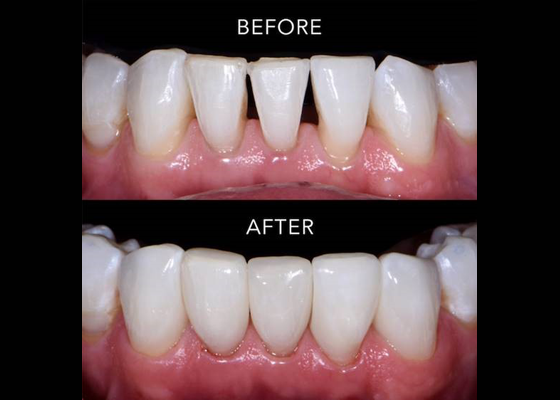Managing caries and motivating change, part 2: Motivational interviewing
How do you motivate your patients? Discover how caries risk assessments and motivational interviewing tactics can help you connect with…


With the rise in patient awareness and concern about black triangles, are you prepared to offer a solution?
Black triangles, or open gingival embrasures are a common dental issue that may occur in 67% of adults ages 20 and up.1,2 Despite their prevalence, black triangles have only recently become a common esthetic complaint for patients. A patient survey ranked black triangles as the third most disliked esthetic problem, above crowding and dark teeth.1,3 The irony is that countless whitening options are available to patients and an increasing number of adults are pursuing elective orthodontic treatment for a more youthful smile. However, 40% of adult orthodontic cases may result in black triangles.1 Negative spaces that appear during the relatively short treatment time are more readily noticed by patients. For an adult who has just completed orthodontic treatment, the occurrence of these black triangles can be incredibly disappointing – and may be a possible informed consent concern. With the rise in patient awareness and demand, dental professionals should take a more active role in black triangle management before and after orthodontic treatment.
While it’s easy to minimize black triangles as simply an esthetic issue, particularly in less severe cases, these unassuming gaps can impact function and quality of life. Lateral impaction of food debris is a social embarrassment and can contribute to tissue inflammation. Black triangles with cementum or dentin exposure are more prone to biofilm accumulation and have a higher risk of caries. Repeated scaling of calculus from root surfaces can exacerbate the cycle of cementum and dentin exposure, biofilm accumulation, gingival inflammation and recession, and possible enlargement of gaps.
Historically dental professionals have avoided addressing black triangles due to lack of simple and predictable solutions. Some existing treatment modalities are as follows:
Surgical solutions include bone and soft tissue grafts, as well as papilla reconstruction and volumizing. While some of these methods can be invasive and have long recovery periods, newer methods rely on preserving papilla, minimizing trauma, and improving tissue regeneration.10 The success of these solutions are heavily dependent on the quality of hard and soft tissue, blood supply, and skill of the clinician.6,7 Plus, surgical solutions may not be feasible for extreme cases. And, large or hard-to-access areas decrease predictability and may require repeated maintenance.1,4,6
Orthodontic solutions rely on extrusion, tooth repositioning, or root angulation alterations in order to correct black triangles. These methods are best for minor cases, as they are limited by esthetic tooth-size parameters, tooth form, and root proximity. However, orthodontic intervention for black triangles may still require additional restorative refinements and might be best considered if other clinical conditions warrant.1,6,10
Indirect solutions, such as veneers or crowns, are a popular treatment option to address many concerns because of their esthetics, strength, and predictability. The disadvantage is the associated biologic cost – tooth structure may need to be removed if it interferes with paths of insertion and draw.1,6
Direct solutions have the advantage of tooth structure conservation. However, legacy methods of incremental hand placement of white or pink composite resin can be difficult and more prone to voids, defects, and ledges. These imperfections can stain, accumulate biofilm, and lead to gingival inflammation.6,8,9 Plus, this is often considered a temporary, less aesthetic option as compared to indirect methods.
Another direct solution is on the rise that has the advantages of “bonding” while minimizing the handling and placement issues of composite resin.
Injection molding is an innovative minimally invasive additive treatment requiring little to no tooth structure removal. The difference from legacy “bonding” techniques is the use of warmed flowable and regular composite resin that is injected into preformed anatomic mylar matrices. The result is smooth contours in hard-to-access subgingival and interproximal areas. The potential benefits can include better tissue responses and adaptation; reduced biofilm and stain attraction; improved patient hygiene and easier removal of calculus; and orthodontic stability from resulting broad contacts.1,5,6
Any new technique has associated training and equipment investment. However, the learning curve for injection molding is very achievable for the average clinician and the predictable outcomes can be appreciated by clinicians and their patients.
The lack of conversation surrounding black triangles has been an unfortunate trend in orthodontics. Until recently, unpredictable and complex treatment options had clinicians shying away from offering a solution. However, it’s important to inform patients about the potential for black triangles before orthodontic treatment as is having the knowledge and skillset to offer a predictable and affordable solution. Injection molding is an exciting option that offers the ease of a simplified method with predictable and excellent outcomes. Injection molding skills can greatly expand a clinician’s offering of conservative treatment options that patients will request.
Sources

How do you motivate your patients? Discover how caries risk assessments and motivational interviewing tactics can help you connect with…

Caries is a complicated multifactorial disease. In this two-part series, explore how caries risk assessments can help improve evaluation and…

Zirconia may be part of your everyday vocabulary, but how much do you know about this ceramic material? Learn more…